Avoid losing your email account via "Upgrade Account" phishing emails
Phishing/ScamAlso Known As: Upgrade Account spam
Get free scan and check if your device is infected.
Remove it nowTo use full-featured product, you have to purchase a license for Combo Cleaner. Seven days free trial available. Combo Cleaner is owned and operated by RCS LT, the parent company of PCRisk.com.
What is the "Upgrade Account" scam email?
"Upgrade Account email scam" refers to a spam campaign, a large-scale operation during which scam emails are sent by the thousand. The messages distributed through this campaign claim that recipients' email accounts will be deactivated unless they update them.
This deceptive email aims to promote a phishing website, which is disguised as the email account sign-in page. Information entered into this web page (i.e., email addresses and passwords) are recorded and sent to the scammers behind the "Upgrade Account" spam campaign.
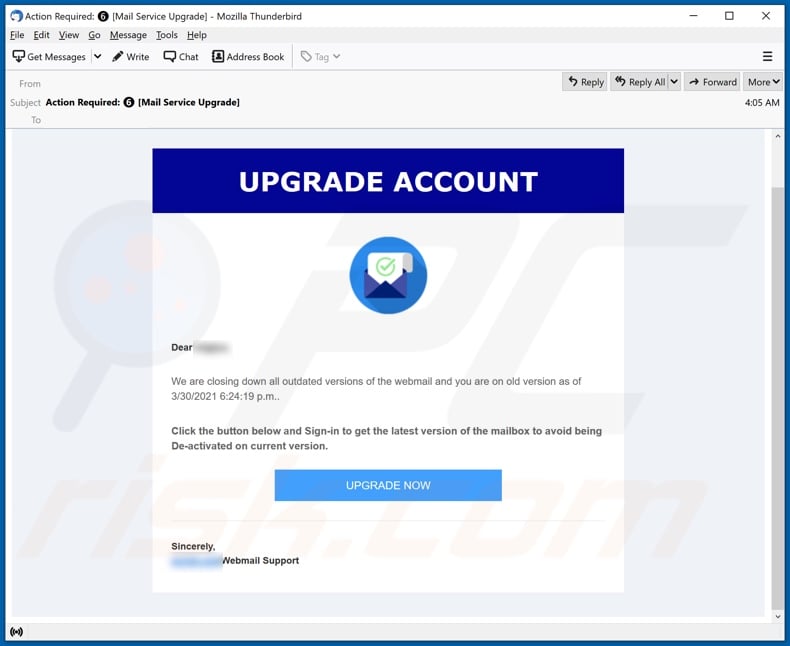
"Upgrade Account" email scam overview
The "Upgrade Account" scam emails (subject/title "Action Required: ❻ [Mail Service Upgrade]") state that all outdated email versions will be deactivated. The messages inform recipients that their email accounts are outdated.
To prevent deactivation, the emails instruct users to sign in and upgrade their accounts to the latest version. The "UPGRADE NOW" button redirects to a phishing site.
It appears as an email sign-in page, however, instead of accessing their accounts, users inadvertently expose their log-in credentials (email addresses and passwords). In this way, the scammers can gain access and control over the corresponding mail accounts.
Email accounts are especially targeted by scammers and cyber criminals, as they are typically connected with other platforms and services. Hence, through stolen emails, access/control may be gained over the accounts associated with them.
To elaborate on how they can be used, on hijacked communication platforms (e.g., emails, social media, social networking, messengers, etc.), scammers can claim to be the genuine owner and ask contacts/friends/followers for loans.
Alternatively, malware can be proliferated (by sharing infectious files) through these platforms. Finance-rated accounts (e.g., banking, online money transferring, e-commerce, digital wallet, etc.) can be used to make fraudulent transactions and online purchases.
To summarize, by trusting the "Upgrade Account" emails, recipients can experience severe privacy issues, financial losses, and identity theft. Should attempts to log-in through the scam website have already been made, change the passwords of potentially compromised accounts.
Additionally, contact the official support of the endangered platforms.
| Name | Upgrade Account Email Scam |
| Threat Type | Phishing, Scam, Social Engineering, Fraud |
| Fake Claim | Emails claim the recipient's mail account will be deactivated unless they upgrade it. |
| Symptoms | Unauthorized online purchases, changed online account passwords, identity theft, illegal access of the computer. |
| Distribution methods | Deceptive emails, rogue online pop-up ads, search engine poisoning techniques, misspelled domains. |
| Damage | Loss of sensitive private information, monetary loss, identity theft. |
| Malware Removal (Windows) |
To eliminate possible malware infections, scan your computer with legitimate antivirus software. Our security researchers recommend using Combo Cleaner. Download Combo CleanerTo use full-featured product, you have to purchase a license for Combo Cleaner. 7 days free trial available. Combo Cleaner is owned and operated by RCS LT, the parent company of PCRisk.com. |
Phishing spam campaign examples
"DENTIN METAL ENGINEERING", "GoDaddy email scam", and "Facebook Lottery" are some examples of other phishing spam campaigns. The messages sent through these mass-scale operations are usually presented as "official", "urgent", "priority", and similar.
The emails can even be disguised as mail from legitimate institutions, authorities, organizations, companies, businesses, service providers, and other entities. Spam campaigns are used for phishing, various scams, and malware (e.g., trojan, ransomware, etc.) distribution.
Due the widespread nature of spam mail, exercise caution with incoming emails.
How do spam campaigns infect computers?
Systems are often infected via malicious files distributed through spam campaigns. These files can be attached and/or linked inside the emails. Infectious files can be in various formats (e.g. Microsoft Office and PDF documents, archive and executable files, JavaScript, etc.).
When these files are executed, run or otherwise opened, the infection process (i.e. malware download/installation) is triggered. For example, Microsoft Office documents (e.g. "Invoice_24077.xlsb") cause infections by executing malicious macro commands.
In Microsoft Office versions released prior to 2010, malware download/installation begins when an infectious document is opened, however, newer versions have "Protected View" mode that prevents automatic execution of macros. Instead, users are asked to enable macro commands (i.e., to enable editing/content) and hence infection processes can only be started by manually enabling macros.
How to avoid installation of malware
To avoid infecting the system with malware spread through spam mail, you are strongly advised not to open suspicious or irrelevant emails, especially those with any attachments or links present in them. Use official and verified download channels.
Additionally, all programs must be activated and updated with tools/functions provided by legitimate developers, since illegal activation tools ("cracks") and third party updaters commonly proliferate malicious software.
To ensure device integrity and user safety, it is paramount to have reputable anti-virus/anti-spyware software installed and kept updated. Furthermore, use these programs to run regular system scans and to remove detected/potential threats.
Do not trust irrelevant emails that contain attachments or website links, especially if received from unknown, suspicious addresses.
Fake update tools infect systems by installing malicious programs rather than updates/fixes for installed software, or by exploiting bugs/flaws of outdated software that is installed on the computer.
Further encryption of any unaffected files can be prevented by uninstalling the ransomware, however, already compromised files remain encrypted even after removal of the rogue software and can only be recovered from a backup.
If you have already opened malicious attachments, we recommend running a scan with Combo Cleaner Antivirus for Windows to automatically eliminate infiltrated malware.
Text presented in the "Upgrade Account" scam email message:
Subject: Action Required: ❻ [Mail Service Upgrade]
UPGRADE ACCOUNT
Dear ********,
We are closing down all outdated versions of the webmail and you are on old version as of 3/30/2021 6:24:19 p.m..
Click the button below and Sign-in to get the latest version of the mailbox to avoid being De-activated on current version.
UPGRADE NOW
Sincerely,
******** Webmail Support
Screenshot of the phishing website promoted through the "Upgrade Account" spam campaign:
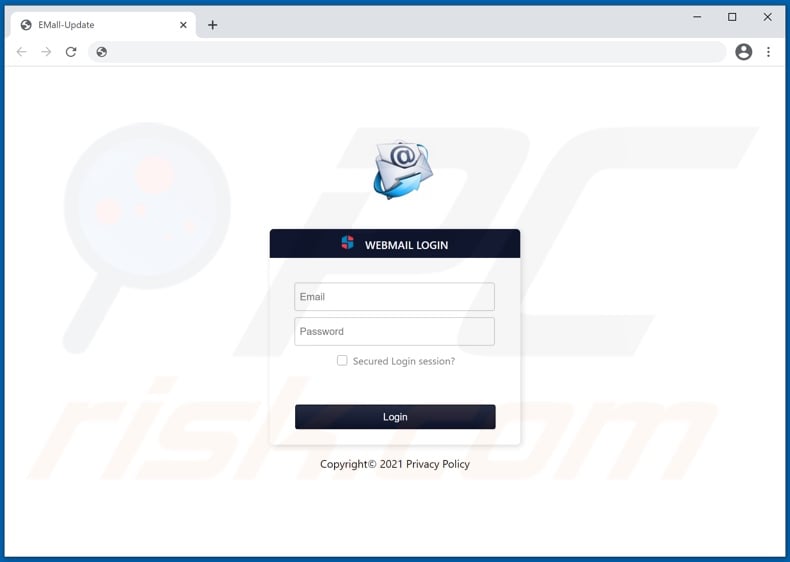
Another example of email upgrade (update)-themed spam used to promote a phishing website:
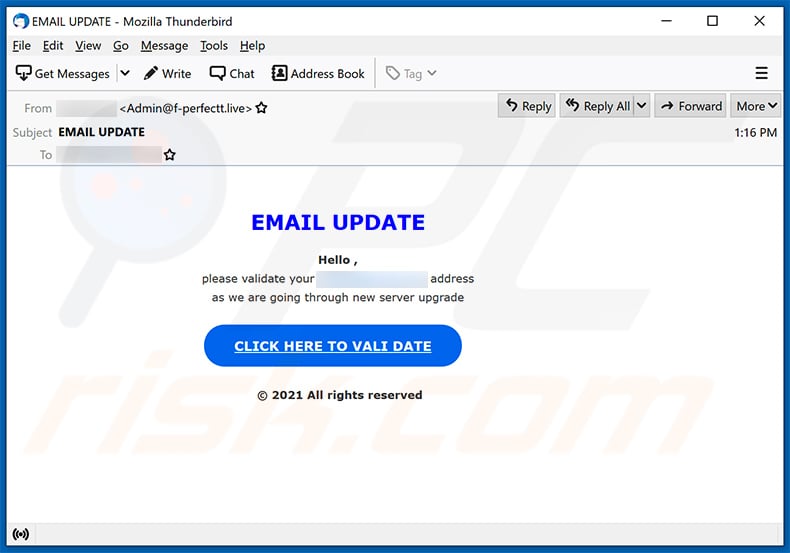
Text presented within:
Subject: EMAIL UPDATE
EMAIL UPDATE
Hello ,
please validate your ******** address
as we are going through new server upgrade
CLICK HERE TO VALI DATE© 2021 All rights reserved
Screenshot of the promoted phishing website:
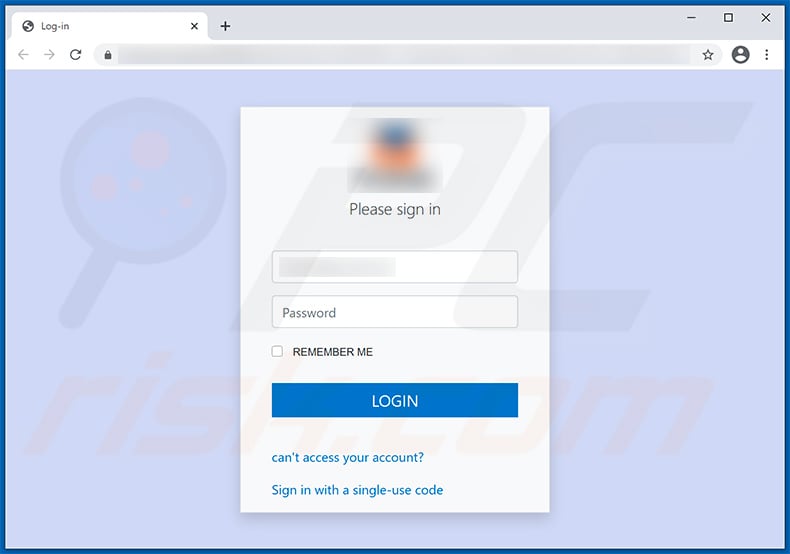
Another email upgrade-themed spam promoting a phishing website:
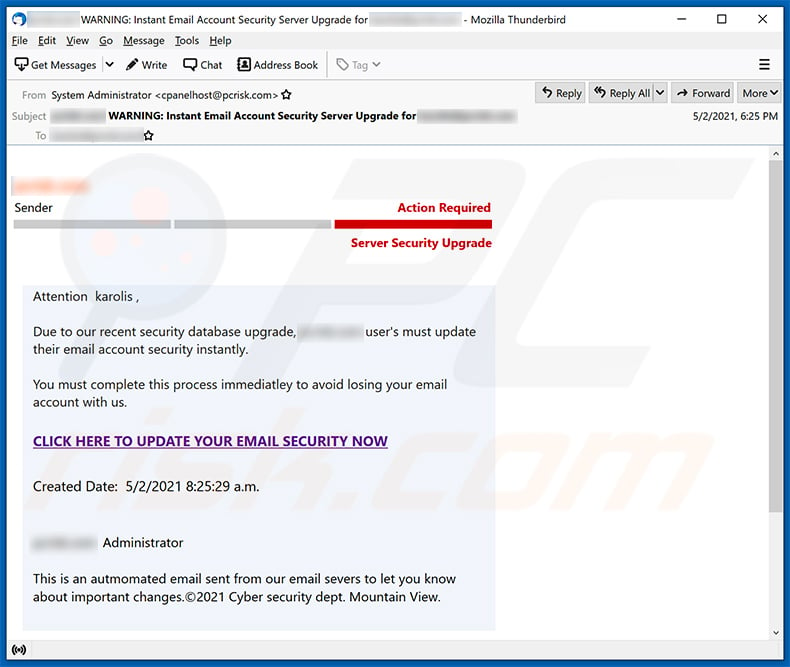
Text presented within:
Subject: ******** WARNING: Instant Email Account Security Server Upgrade for ********
********
Sender Action RequiredServer Security Upgrade
Attention ********,
Due to our recent security database upgrade, ******** user's must update their email account security instantly.
You must complete this process immediatley to avoid losing your email account with us.
CLICK HERE TO UPDATE YOUR EMAIL SECURITY NOW
Created Date: 5/2/2021 8:25:29 a.m.
******** AdministratorThis is an autmomated email sent from our email severs to let you know about important changes.©2021 Cyber security dept. Mountain View.
Screenshot of the promoted phishing website:
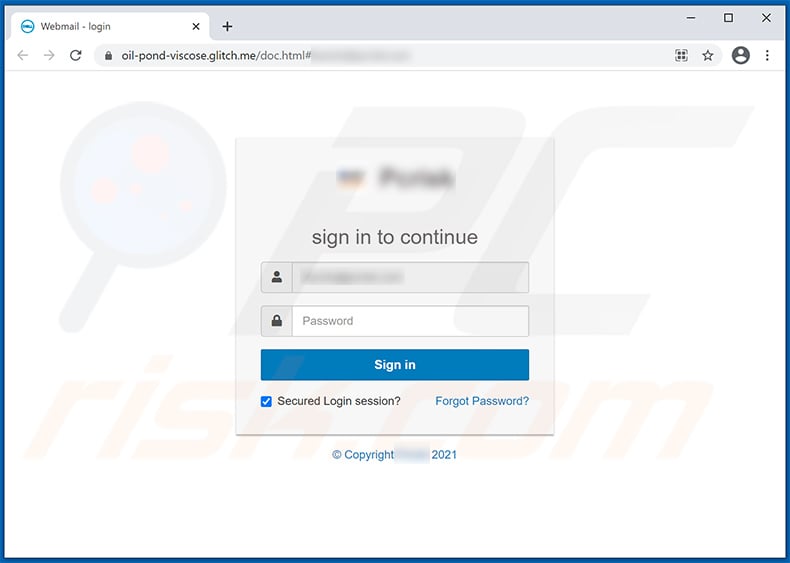 \
\
Yet another example of email upgrade-themed spam promoting a phishing site:
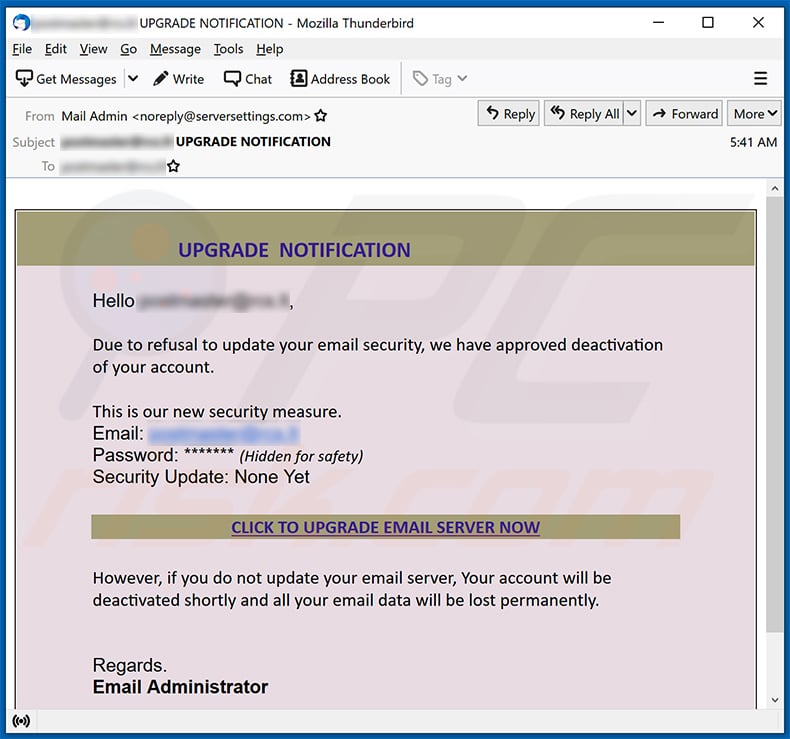
Text presented within:
Subject: ******** UPGRADE NOTIFICATION
UPGRADE NOTIFICATION
Hello ********,
Due to refusal to update your email security, we have approved deactivation of your account.
This is our new security measure.
Email: ********
Password: ******* (Hidden for safety)
Security Update: None Yet
CLICK TO UPGRADE EMAIL SERVER NOW
However, if you do not update your email server, Your account will be deactivated shortly and all your email data will be lost permanently.Regards.
Email Administrator
Screenshot of the promoted phishing site (madnesscrew[.]ro):
![Phishing site promoted via Upgrade Email spam (madnesscrew[.]ro)](/images/stories/screenshots202107/upgrade-email-spam-2021-07-16-phishing-site.jpg)
Yet another email update-themed spam promoting a phishing site:
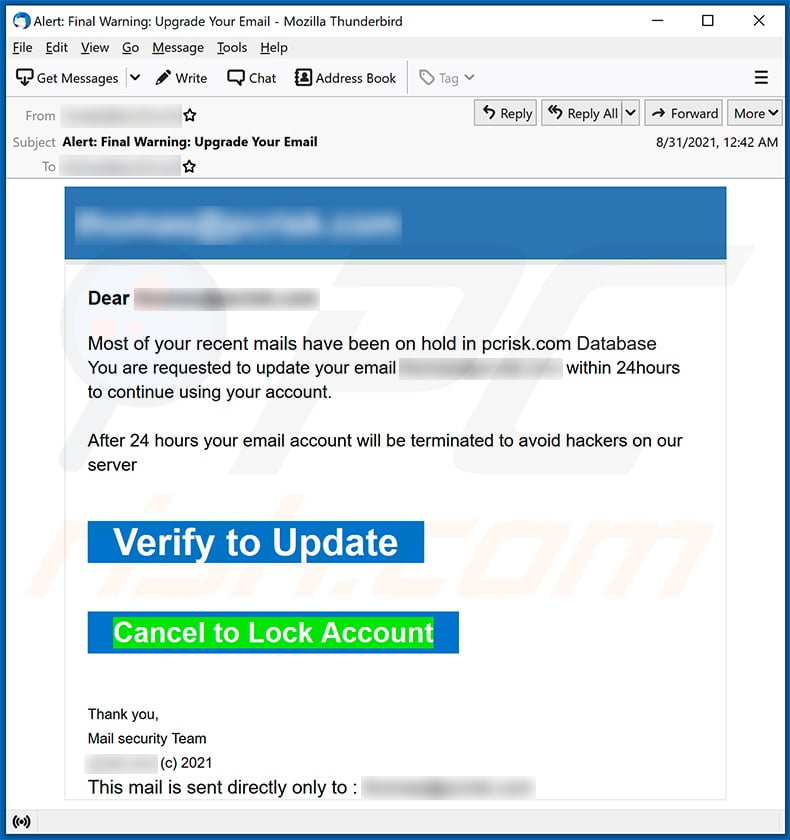
Text presented within:
Subject: Alert: Final Warning: Upgrade Your Email
********
Dear ********
Most of your recent mails have been on hold in ******** Database
You are requested to update your email ******** within 24hours
to continue using your account.After 24 hours your email account will be terminated to avoid hackers on our server
Verify to Update
Cancel to Lock Account
Thank you,
Mail security Team
********* (c) 2021
This mail is sent directly only to : ********
Screenshot of the promoted phishing website:
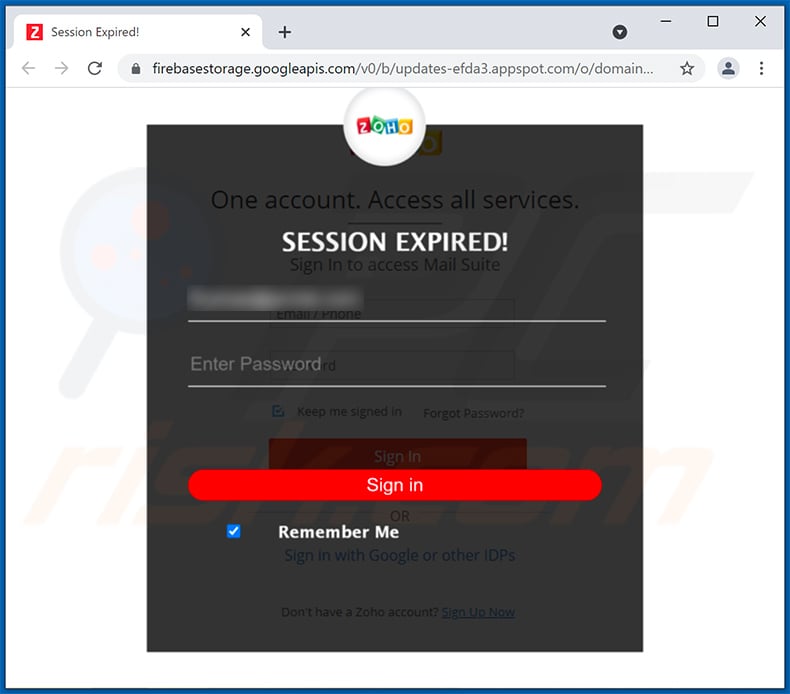
Yet another example of email upgrading-themed spam:
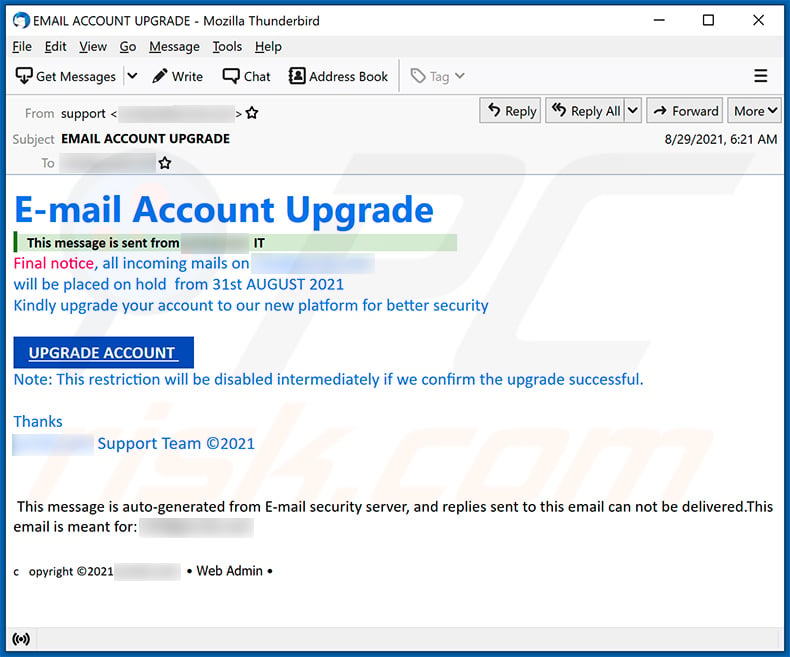
Text presented within:
Subject: EMAIL ACCOUNT UPGRADE
E-mail Account Upgrade
This message is sent from ******** IT
Final notice, all incoming mails on ********
will be placed on hold from 31st AUGUST 2021
Kindly upgrade your account to our new platform for better securityUPGRADE ACCOUNT
Note: This restriction will be disabled intermediately if we confirm the upgrade successful.Thanks
******** Support Team ©2021This message is auto-generated from E-mail security server, and replies sent to this email can not be delivered.This email is meant for: ********
c opyright ©2021 pcrisk.com • Web Admin •
Another example of email upgrade-themed spam used to promote a phishing site:
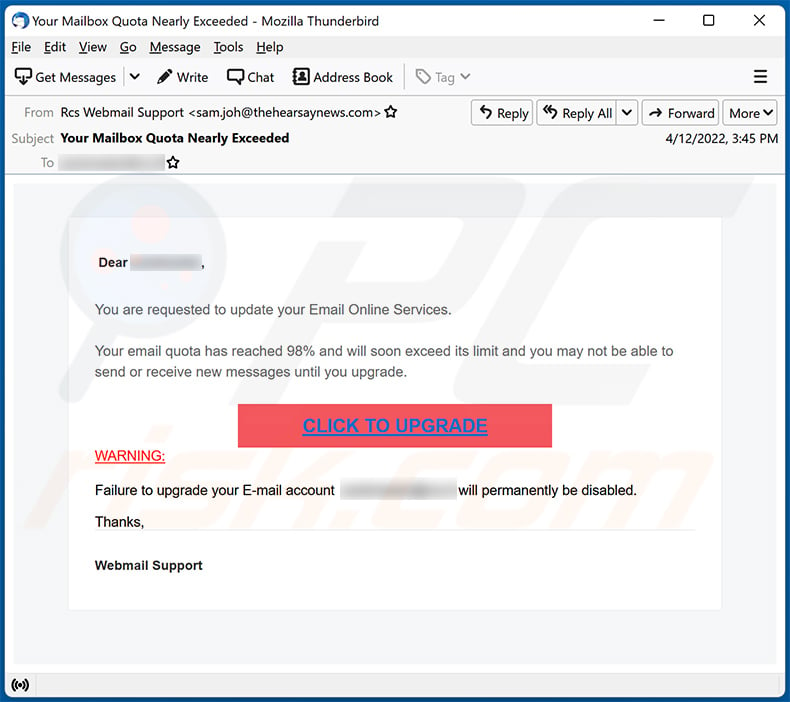
Text presented within:
Subject: Your Mailbox Quota Nearly Exceeded
Dear -,
You are requested to update your Email Online Services.
Your email quota has reached 98% and will soon exceed its limit and you may not be able to send or receive new messages until you upgrade.
CLICK TO UPGRADE
WARNING:
Failure to upgrade your E-mail account - will permanently be disabled.
Thanks,
Webmail Support
Another example of account upgrading-themed spam promoting a phishing site:
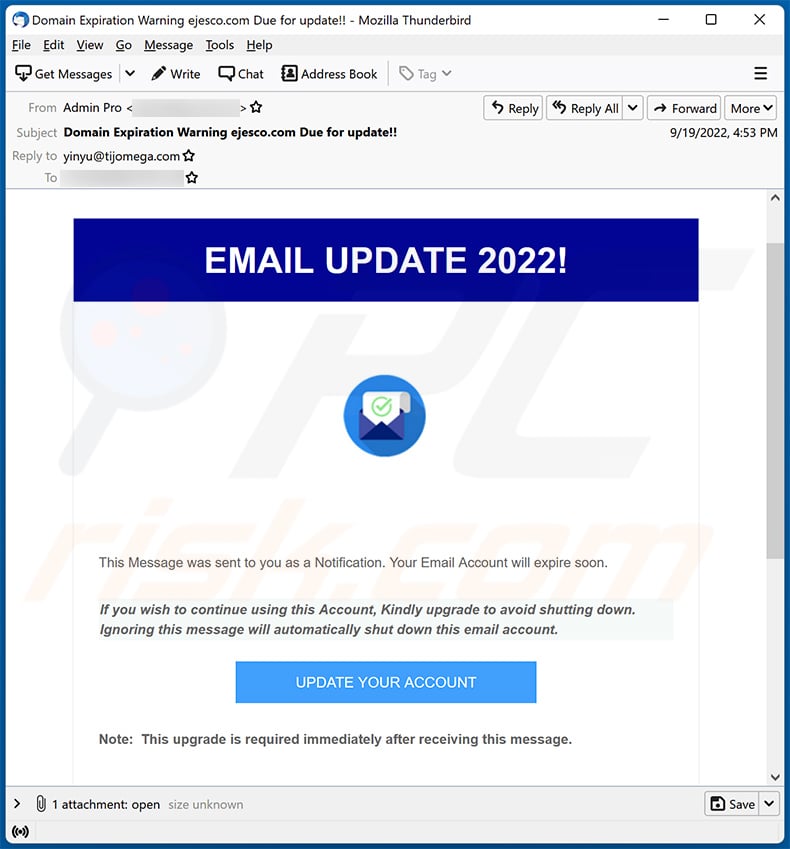
Text presented within:
Subject: Domain Expiration Warning - Due for update!!
EMAIL UPDATE 2022!
This Message was sent to you as a Notification. Your Email Account will expire soon.
If you wish to continue using this Account, Kindly upgrade to avoid shutting down. Ignoring this message will automatically shut down this email account.
UPDATE YOUR ACCOUNT
Note: This upgrade is required immediately after receiving this message.
Yet another example of an email from "Upgrade Account" spam campaign:
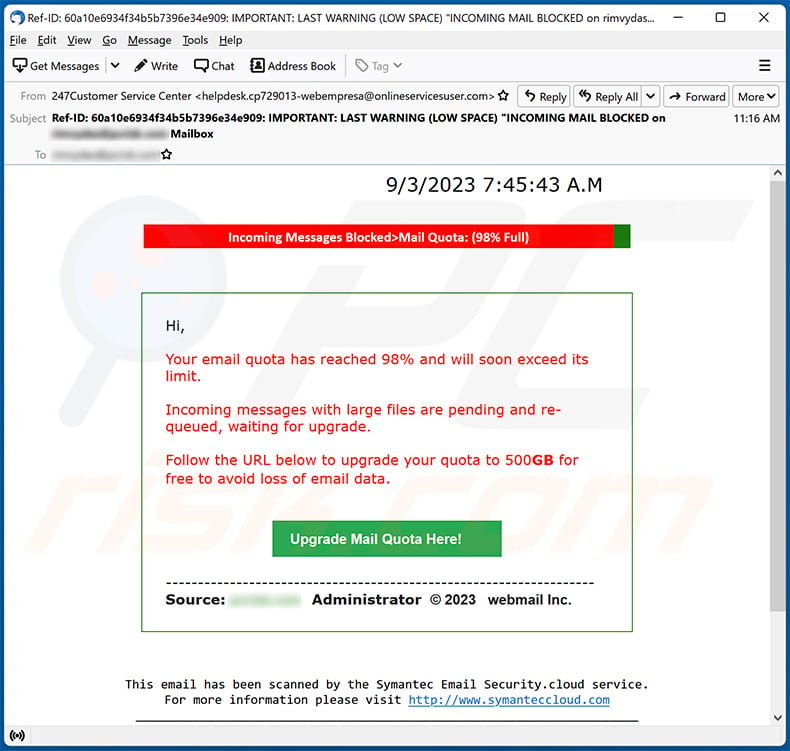
Text presented within:
Subject: Ref-ID: 60a10e6934f34b5b7396e34e909: IMPORTANT: LAST WARNING (LOW SPACE) "INCOMING MAIL BLOCKED on - Mailbox
9/3/2023 7:45:43 A.M
Incoming Messages Blocked>Mail Quota: (98% Full)Hi,
Your email quota has reached 98% and will soon exceed its limit.
Incoming messages with large files are pending and re-queued, waiting for upgrade.
Follow the URL below to upgrade your quota to 500GB for free to avoid loss of email data.
Upgrade Mail Quota Here!
Screenshot of the promoted phishing site:
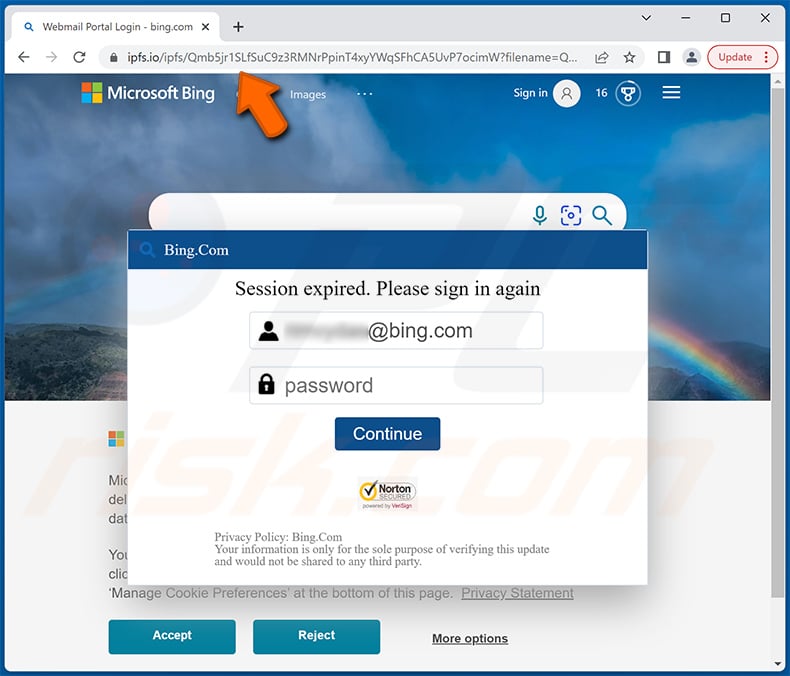
Instant automatic malware removal:
Manual threat removal might be a lengthy and complicated process that requires advanced IT skills. Combo Cleaner is a professional automatic malware removal tool that is recommended to get rid of malware. Download it by clicking the button below:
DOWNLOAD Combo CleanerBy downloading any software listed on this website you agree to our Privacy Policy and Terms of Use. To use full-featured product, you have to purchase a license for Combo Cleaner. 7 days free trial available. Combo Cleaner is owned and operated by RCS LT, the parent company of PCRisk.com.
Quick menu:
- What is Upgrade Account spam?
- Types of malicious emails.
- How to spot a malicious email?
- What to do if you fell for an email scam?
Types of malicious emails:
![]() Phishing Emails
Phishing Emails
Most commonly, cybercriminals use deceptive emails to trick Internet users into giving away their sensitive private information, for example, login information for various online services, email accounts, or online banking information.
Such attacks are called phishing. In a phishing attack, cybercriminals usually send an email message with some popular service logo (for example, Microsoft, DHL, Amazon, Netflix), create urgency (wrong shipping address, expired password, etc.), and place a link which they hope their potential victims will click on.
After clicking the link presented in such email message, victims are redirected to a fake website that looks identical or extremely similar to the original one. Victims are then asked to enter their password, credit card details, or some other information that gets stolen by cybercriminals.
![]() Emails with Malicious Attachments
Emails with Malicious Attachments
Another popular attack vector is email spam with malicious attachments that infect users' computers with malware. Malicious attachments usually carry trojans that are capable of stealing passwords, banking information, and other sensitive information.
In such attacks, cybercriminals' main goal is to trick their potential victims into opening an infected email attachment. To achieve this goal, email messages usually talk about recently received invoices, faxes, or voice messages.
If a potential victim falls for the lure and opens the attachment, their computers get infected, and cybercriminals can collect a lot of sensitive information.
While it's a more complicated method to steal personal information (spam filters and antivirus programs usually detect such attempts), if successful, cybercriminals can get a much wider array of data and can collect information for a long period of time.
![]() Sextortion Emails
Sextortion Emails
This is a type of phishing. In this case, users receive an email claiming that a cybercriminal could access the webcam of the potential victim and has a video recording of one's masturbation.
To get rid of the video, victims are asked to pay a ransom (usually using Bitcoin or another cryptocurrency). Nevertheless, all of these claims are false - users who receive such emails should ignore and delete them.
How to spot a malicious email?
While cyber criminals try to make their lure emails look trustworthy, here are some things that you should look for when trying to spot a phishing email:
- Check the sender's ("from") email address: Hover your mouse over the "from" address and check if it's legitimate. For example, if you received an email from Microsoft, be sure to check if the email address is @microsoft.com and not something suspicious like @m1crosoft.com, @microsfot.com, @account-security-noreply.com, etc.
- Check for generic greetings: If the greeting in the email is "Dear user", "Dear @youremail.com", "Dear valued customer", this should raise suspiciousness. Most commonly, companies call you by your name. Lack of this information could signal a phishing attempt.
- Check the links in the email: Hover your mouse over the link presented in the email, if the link that appears seems suspicious, don't click it. For example, if you received an email from Microsoft and the link in the email shows that it will go to firebasestorage.googleapis.com/v0... you shouldn't trust it. It's best not to click any links in the emails but to visit the company website that sent you the email in the first place.
- Don't blindly trust email attachments: Most commonly, legitimate companies will ask you to log in to their website and to view any documents there; if you received an email with an attachment, it's a good idea to scan it with an antivirus application. Infected email attachments are a common attack vector used by cybercriminals.
To minimise the risk of opening phishing and malicious emails we recommend using Combo Cleaner Antivirus for Windows.
Example of a spam email:

What to do if you fell for an email scam?
- If you clicked on a link in a phishing email and entered your password - be sure to change your password as soon as possible. Usually, cybercriminals collect stolen credentials and then sell them to other groups that use them for malicious purposes. If you change your password in a timely manner, there's a chance that criminals won't have enough time to do any damage.
- If you entered your credit card information - contact your bank as soon as possible and explain the situation. There's a good chance that you will need to cancel your compromised credit card and get a new one.
- If you see any signs of identity theft - you should immediately contact the Federal Trade Commission. This institution will collect information about your situation and create a personal recovery plan.
- If you opened a malicious attachment - your computer is probably infected, you should scan it with a reputable antivirus application. For this purpose, we recommend using Combo Cleaner Antivirus for Windows.
- Help other Internet users - report phishing emails to Anti-Phishing Working Group, FBI’s Internet Crime Complaint Center, National Fraud Information Center and U.S. Department of Justice.
Frequently Asked Questions (FAQ)
Why did I receive this email?
Spam emails are not personal. Cyber criminals distribute these letters by the thousand with the hopes that at least some of the recipients will fall for their scams.
I have provided my personal information when tricked by this spam email, what should I do?
If you have provided account credentials - change the passwords of all potentially compromised accounts and inform their official support without delay. And if you've disclosed other private information (e.g., ID card details, credit card numbers, etc.) - immediately contact the corresponding authorities.
I have read a spam email but didn't open the attachment, is my computer infected?
No, merely reading a spam email will not initiate any system infection processes. Malware download/installation is jumpstarted when the attachments or links present in this mail are opened/clicked.
I have downloaded and opened a file attached to a spam email, is my computer infected?
Whether an infection occurred may depend on the opened file's format. If it was an executable (.exe, .run, etc.) - most likely, yes - your system was infected. However, document formats (.doc, .xls, .pdf, etc.) may require additional interaction (e.g., enabling macro commands) - to start downloading/installing malware.
Will Combo Cleaner remove malware infections present in email attachments?
Yes, Combo Cleaner can detect and eliminate almost all known malware infections. It must be stressed that running a complete system scan is paramount - since sophisticated malware tends to hide deep within systems.
Share:

Tomas Meskauskas
Expert security researcher, professional malware analyst
I am passionate about computer security and technology. I have an experience of over 10 years working in various companies related to computer technical issue solving and Internet security. I have been working as an author and editor for pcrisk.com since 2010. Follow me on Twitter and LinkedIn to stay informed about the latest online security threats.
PCrisk security portal is brought by a company RCS LT.
Joined forces of security researchers help educate computer users about the latest online security threats. More information about the company RCS LT.
Our malware removal guides are free. However, if you want to support us you can send us a donation.
DonatePCrisk security portal is brought by a company RCS LT.
Joined forces of security researchers help educate computer users about the latest online security threats. More information about the company RCS LT.
Our malware removal guides are free. However, if you want to support us you can send us a donation.
Donate
▼ Show Discussion